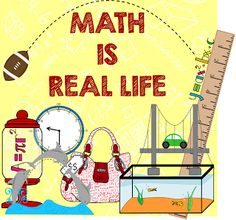One of the fundamental reasons as to why I chose the Discovering Mathematics module was to overcome my own problems in mathematics. Referring back to my first mathematics blog post, I discussed some of the issues I faced in mathematics and my hope of overcoming them throughout the module. One of the issues I aimed to overcome was the attitude of ‘why maths?’, why is mathematics so important to me? Well, mathematics is important to me as it is part of absolutely everything I do in to my day-to-day life, and I am not over exaggerating when I say everything. The Discovering Mathematics module has opened up my eyes to a whole new perspective of mathematics and away from education.
I can’t say that immediately my view on mathematics changed it has been only very recently that everything started coming together. At the start of the module I found it difficult to grasp the concept of viewing mathematics away from educational applications and taking my teacher hat off. I realise now that as an education student, soon to be teacher, this is such an important trait to have and for that I am grateful to the module. Throughout my time on placement I can’t emphasize the amount of times I heard, “maths is boring”, “why do we have to do this” and to be honest I did not have an answer. I knew it was boring, and I wasn’t sure of the relevance of the topic, I just knew that I learned that, people before me learned that and that’s just what we had to do. Now, going in to next year’s placement I aim to challenge these views and now I can successfully give the children an answer.
Math is boring if you make it boring, the module has opened my eyes to a whole new way of teaching mathematics. Mathematics is a tricky topic and it is difficult to grasp however the current teaching of mathematics has no relevance to the children. The Discovering Mathematics showed me the mathematics that surrounds me and that is in my daily life. The buildings I enter are all built using mathematics; the golden ratio and measuring. The doctors who look after me use mathematics in prescribing my medicine. The music I listen to all includes mathematics such as counting beats, rhythm and patterns. Then of course the obvious mathematics I use such as telling the time, handling money and driving. There is never a truer statement when someone says mathematics is all around us. Nature represents mathematics such as the golden ratio which is represented in plants and the shape of countries. By making this clear with children and showing them mathematical links in the world away from “education” I aim to challenge the view of “why are we learning this?”
By looking at Liping Ma’s profound understanding of fundamental mathematics (PUFM) this has allowed me to understand there is more to mathematics than just knowing the methods. Through looking in great depth at PUFM and what makes a teacher have PUFM I feel this has again provided me with a new perspective of mathematics. Ma discusses that mathematics is about not just knowing how to do something but knowing why and knowing this with breadth, depth and thoroughness. Again, by applying this to the classroom will give children an understanding of why they are learning a particular topic instead of just learning the methods and memorising it. Another crucial part of PUFM is having the ability to make connections with mathematical concepts. This could also be beneficial within the classroom, if a child is not understanding a particular concept having the ability to show them similar techniques of a less complicated form could make mathematics less daunting for them and hopefully guidance they could begin to create their own links.
I am glad I picked the discovering mathematics module as although it was not designed for the purpose of education I feel it will benefit me greatly in teaching. It has challenged my own negative views of mathematics and that you don’t have to be a ‘whizz’ in order to be good at mathematics and has provided me with more confidence which as a result will ensure I am a more confident teacher. It also has allowed me to make mathematical connections with topic’s I would never had associated with mathematics.
















